
We are reader-supported and may earn a commission on purchases made through links in this article.
My previous visits to Venice have always been so immersive and satisfying. Thanks to the guidance of I.C. Bellagio, Italy’s top custom private tour company, I have seen behind the scenes.
This includes classical concerts in Vivaldi’s church; local prosecco and cicchetti food tasting; traditional Venetian carnival mask-making; after-hours access to Basilica San Marco; walking tours of the Jewish Ghetto, Rialto Bridge and the Fish Market; gondola rides on the Grand Canal; and art tours of Palazzo Ducale, the Guggenheim Collection and Gallerie dell’Accademia.
Guided by experts and arranged by I.C. Bellagio’s connected guest ambassadors, I boarded boats to Murano for a glass-making demonstration. I also went to the island of Torcello to see Ernest Hemingway’s duck hunting hotel, the Locanda Cipriani. Plus, I stepped ashore to see the hand-made lacework and brightly colored homes on Burano. More than once, I drank Bellini at Harry’s Bar, where the peach puree and prosecco potion was invented.
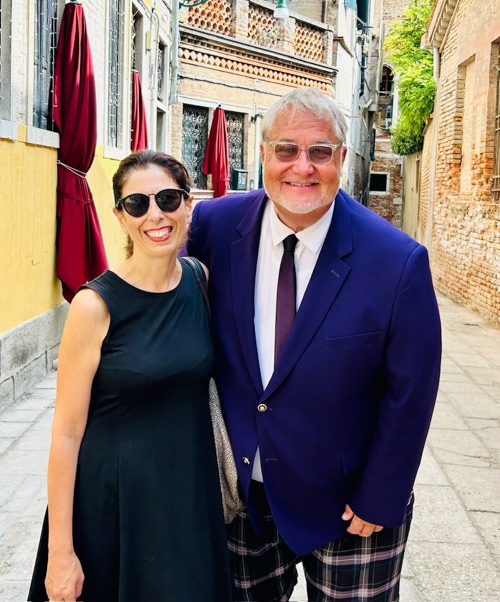
Contact IC Bellagio.com and let them arrange these experiences for you in Venice and water taxi transfers. Plus astonishing, panoramic lodging at the Londra Palace Hotel, steps from the Bridge of Sighs and Piazza San Marco.
Admittedly, there is still much more for me to see, experience and learn in Venice.
But recently, I wanted my Venice experience to be something different.
Wanting to Wander
After flying from America to participate in a three-day conference in London, I decided I should take advantage of being on the other side of the pond by sticking around for a while.
Where should I hang out for a week?
As a travel writer, I am always torn between the duty to experience new destinations and revisit places I am fond of.
Every single day since my very first Venetian visit at Christmas of 2016, I have thought about its ethereal appearance and ornate architecture. Plus, of course, Venezia’s “streets full of water,” as humorist Robert Benchley described its 150 canals.
I had been back to Venice twice in 2022—both brief but dramatic and memorable stays.
“How many days in my life might I have left to spend in a place that is in my daily thoughts?” I asked myself. At 56 years old, I hesitated to do the math. If I had the opportunity to pop down from Heathrow to Marco Polo International Airport (where you can board a boat or bus to get into Venice), I figured I should do it.
But I wanted this week, no matter where I chose to spend it, to be different than my usual spree. This time, I just wanted to hang around. No schedule, no itinerary, no meetings, no tours and no fuss.
In admittedly a bit of hyperbole, I wanted this Venice visit to be in the fashion of Henry David Thoreau. My own personal “Walden,” a better understanding of Venice by “stripping away superfluous luxuries and living a plain, simple life in radically reduced conditions.”
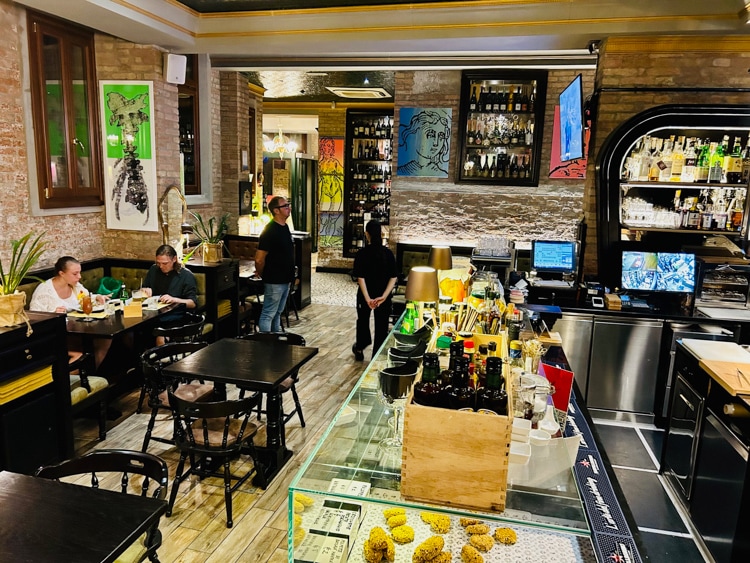
Loving Lingering
Mind you, it’s all relative. Thoreau committed to living in a lakeside, wilderness cabin for two years with no support. I would be feasting on one of the most intoxicating, dreamy cultural destinations in the world.
But in the spirit of Thoreau’s intent, I wanted to see what I could learn from what Venice had to teach and not, when I came to die, discover I had not known her. I wanted to “suck the marrow of Venezia to know it by experience and be able to give a true account of it…”
Thoreau gave it two years.
I had seven days.
Seven days to do nothing. Or anything. Whatever I wanted, any time I wanted. I could rise early and go to Mass or I could sleep in. In addition, I could go out and sit as long as I wanted and I could gather advice for dinner. Or I could take a chance on random places I might stumble across. Heck, I could eat at the same place every day if I pleased.
I would go, unhurried, wherever Venice took me. And breathe it all in.

Photo by Harrison Shiels
Arriving in Corte Loredana
After landing at Marco Polo Airport, though some go by boat, I followed the signs to the ATVO bus. For a ten-Euro biglietti purchased from an automated kiosk the bus drops passengers at Piazzale Roma. There was a lot happening at Piazzalle Roma. It is Venice’s main arrival point, connecting cars, buses and boats with bridges next to the Santa Lucia Railway Stazione.
I was happy in the swim of it all to see Venetian Giulia De Carolis, originally from Puglia. She had agreed to greet me and lead me to Corte Loredana. It’s a popular guesthouse she and her husband Alberto Venerandi own and operate with the assistance of manager Frank Gomies.
Giulia professionally greets and logistically guides visitors, often via IC Bellagio, through their Venetian experience, which can be daunting for some, from arrival to departure. She knows every canal and little lane—from the airport to the docks, hotels and theaters—in Venice. With that knowledge, she had two warnings for me after we exchanged pleasantries in Piazalle Roma:
“Remember, the house, Corte Loredana, is basic. It is not a hotel,” she reminded me, knowing I previously stayed in fancy Venice hotels. “There is no restaurant, cooking, or services.”
“Lo so, lo so. Perfetto, cara mia, amica,” I insisted before Giulia levied the second warning.
“There are a couple of bridges we will have to cross with your luggage if we walk. It is a 10-minute’ walk but can take a traghetto, a boat, if you prefer,” Giulia said, looking at my 28-inch, pink Delsey rolling suitcase and leather duffel bag.
The steps of the first bridge, the 261-foot, arched Ponte Della Costituzione, were the highest, longest. And, the most daunting to drag luggage up and over. After that, any little canal-crossing bridge, such as the Ponte Guglie, had ramps to roll over. The foot of the bridge is where the first wrestling match between Giulia and myself occurred. She tried to grab and carry my duffle bag, which I had balanced atop the rolling suitcase.
As a gentleman, of course, I would not let the dear woman lift that bag.
“You are not a porter, per favore!” I scolded her with a smile. Plus, Giulia was greeting and guiding me because she is a friend.
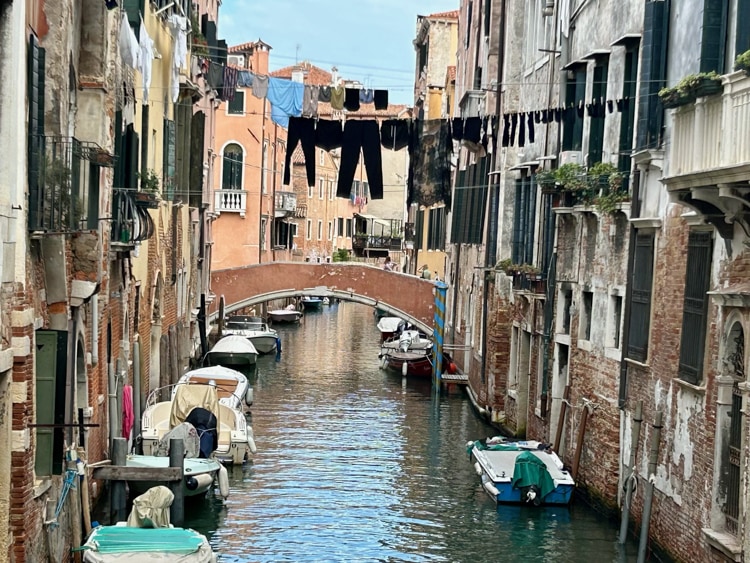
Finding a Home for the Week
Corte Loredana is on a quiet corner next to a canal. However, based on my experience walking there, you will be able to find it, even in the labyrinth of Venice. Plus, there are various waterbus docks, including the San Marcuola or the Guglie, in close proximity to the guesthouse. If I could figure it out, anyone can.
The walk from Piazzale Roma took us through the storefronts and snack bars along a bustling thoroughfare of Rio Tera San Leonardo. As well as the Calle del Pistor, the Calle de l’Anconeta and the Rio Tera Farsetti, to the Calle Ghelt of o Loredana. But Venice is not a place to get caught up in street names. Google Maps will get you there. And you will quickly feel like a local going in and out of its wonderfully secluded location, steps from a spritz.
Having said that, after you check in and go out to excitedly explore Venice, pay attention to your surroundings and location. Make mental notes or take photos of where you are so you can find Corte Loredana on your return. This is good advice for any location in the marvelous maze of Venezia.
Corte Loredana Guest House
Corte Loredana, built in 1928, is a four-story, authentic, tiny Italian villa. The exterior is tastefully subtle yet welcoming. It has yellow walls and a white door frame, above which are dark green shuttered windows amid rose-colored brick.
Venerandi’s father owned a hotel near Piazza San Marco. He also previously owned a full-service hotel property near Campo Sant’ Apostoli. So, he has decades of experience to draw on when it comes to boiling it down to what visitors to Venice really need at a value price.
The guesthouse has various combinations of rooms. Some have an ensuite, and some have a shared bathroom down the hall. It can often be booked for less than 100 euros per night.
My room was at the top of the first flight of stone stairs with decorative, black, iron, and wooden-topped handrails. (Note: there is no elevator.)
I was given keys to the main door, the first floor door and to my room. They are old-fashioned keys, not electronic ones. So, be careful not to lock yourself out or leave your room and floor without your keys.
There is no “front desk” or concierge in the lobby to simply attend to such matters. However, Gomies, the manager, does live on site, and I saw him frequently in the lobby. There is also a countertop shelf full of local information, including a 24-hour hotline and day/evening What’s App number. The house rules and details about a Corte Loredana stay are also posted.
“This is our (and tonight) your home,” say the instructions, which then ask guests to treat it with respect and be silent at night. Cooking, washing (except underwear), ironing, smoking, and inviting outside guests are prohibited.
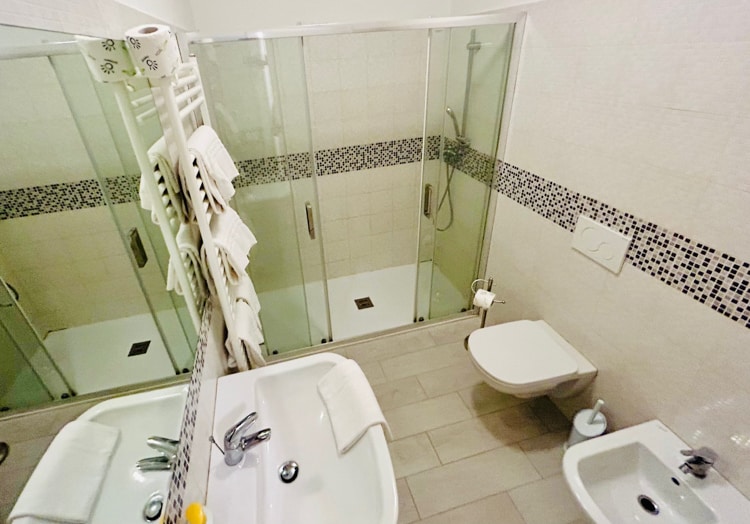
A Simple But Very Comfortable Room
My room was very clean, simple, convenient, functional and pleasantly decorated. It had a modern bathroom with a bidet, a glass shower, and a towel warmer. (Note: bring your own shampoo and soap.) “Most people these days prefer to use their own brands of hair products,” Gomies said. He will provide toilet paper since only a certain brand is friendly to Venetian plumbing.
There were two small nightstands on either side of the bed, each with lamps and power outlets. There was a huge cabinet for hanging your designer Italian clothing or stashing your suitcases and backpacks. The air-conditioned room also had a television above a desk, upon which sat the QR code for free wireless internet. (Note: there is no daily housekeeping service, which is not uncommon post-pandemic, even in some larger hotels.)
I did not plan to be in my room much. Although it had all I needed for comfortable rest in between jaunts. For what I did need, Corte Loredana’s neighborhood location in Venice’s Cannaregio neighborhood, the northernmost sestieri in Venezia, was vibrant and bountiful. I loved the sensation of closing the door on Corte Loredana and heading out with no fanfare. Or unlocking it in the evening upon my return and entering “my building”. It felt as if it were my home.
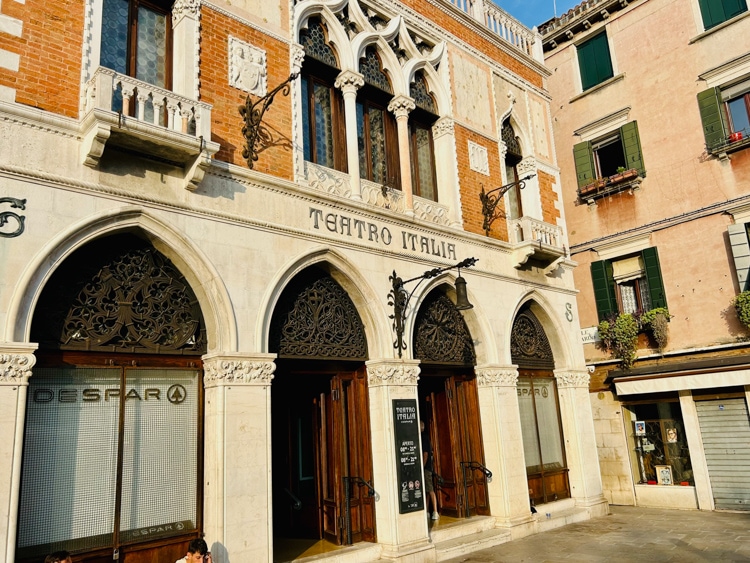
Photo by Harrison Shiels
Nearby Neighborhood Necessities
Before Giulia left, she pointed out, back on Strada Nuova, Teatro Italia Despar. It is a neo-Gothic, Art Nouveau gourmet grocery store that was obviously once a theater. The stage is still there in the store. But, the upscale Italian food choices—fresh fruits, sweets, and meats—are the stars.
The supermarket is so lovely and unique it has become an attraction for tourists and architecture students. I stepped through its columns and arched entrance to shop at Teatro Italia a few times. There were bountiful, colorful flowers and snacking items such as fruit and Pellegrino to keep in my room. Plus treats, such as cappuccino-flavored torrone, to take home.
Two restaurants adjacent to Corte Loredana share ownership, if I understood correctly, both on the canal. If you fell out of the window of Corte Loredana, you would land in either of them.
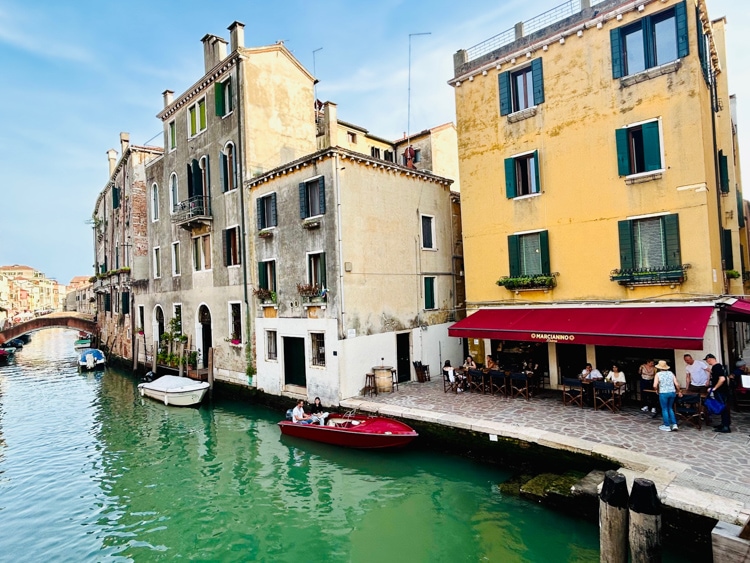
Sister Restaurants
Marcianino l’Osteria, with its red awnings and outdoor seating sits directly on the canal beside a bridge. They serve traditional Venetian food such as cicchetti and fish procured daily and directly from the famed Rialto Fish Market. You must walk right between its diners and the canal if you approach Corte Loredana from the Rio Terra Farsetti side.
If you walk to your digs from the other direction, Callo Di Anconetta, you will find Marciano on the right side of Corte Loredana’s door. The restaurant is a contemporary, snazzy spot serving their own craft beers and cocktails. They also have a modern, American menu offering steaks, pulled pork and ribs. Seating is both inside and streetside under burgundy umbrellas in the narrow passageway of Callo Gheltof next to Corte Loredana.
I saw many people sitting, sipping and softly speaking there as midnight approached. Walk through the restaurant and you will find a few tables on a balcony overlooking the canal.
The warm, appealing interior is exposed-brick walls with eclectic, colorful modern artwork in homage to Venice’s historic painters. There is also a five-shelf, library bookcase of wine bottles dramatically displayed and lit. The Marciano offered falafel and potato and cheese crocchettes from under a glass-top counter.
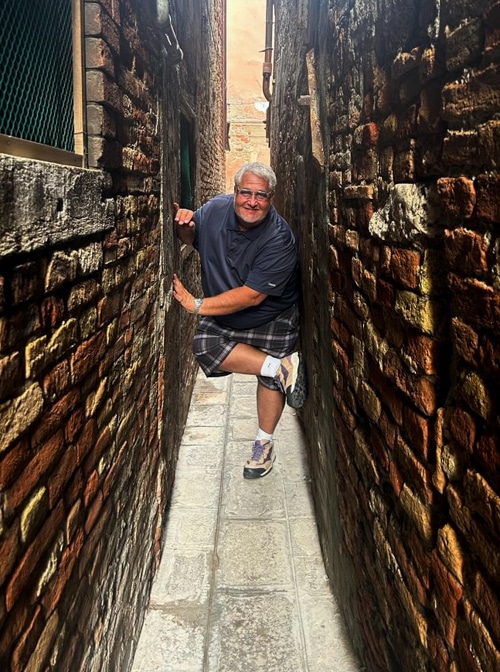
Photo by Harrison Shiels
Intrigue On the Street
Both Marciano and Marcianino l’Osteria are secluded, quieter, and more peaceful compared to the ones lining the Strada Nuova. There, I often made the umbrella-covered tables of the much more casual “Bar Gioig” my last stop of the night on the walk to Corte Loredana. I also confess to stopping at Gelato di Natura, a stone’s throw, for a scoop of stracciatella on the same strada.
Late at night I found Bar Gioig to be a premium place to sit, sip and mentally review the day. It’s also a great spot to people watch as they made their way over the small bridge passing between my outdoor seat and the closed Teatro Italia.
On the first night, a carnival-barker waiter from Sicily beckoned me to sit. The insistence of the sales pitches, Palermo-style, did not stop there. He tried, for two nights, to make me an offer I couldn’t refuse.
“Go back to America, sell everything, and invest in a business here with me.” he suggested in broken but entertaining English. I was swallowing my Spritz, but not his story, which was funny at first but began to wear on me. “Or sell everything and live on a boat. Get some girls. Why not?”
On the second moonlit night outside Bar Gioig, I sat in solitude among many empty seats. That is until a gray-haired gentleman in a blazer asked, in English, if he could sit near me.
“Si, si, cierto,” I signor,” I answered gesturing to a chair.
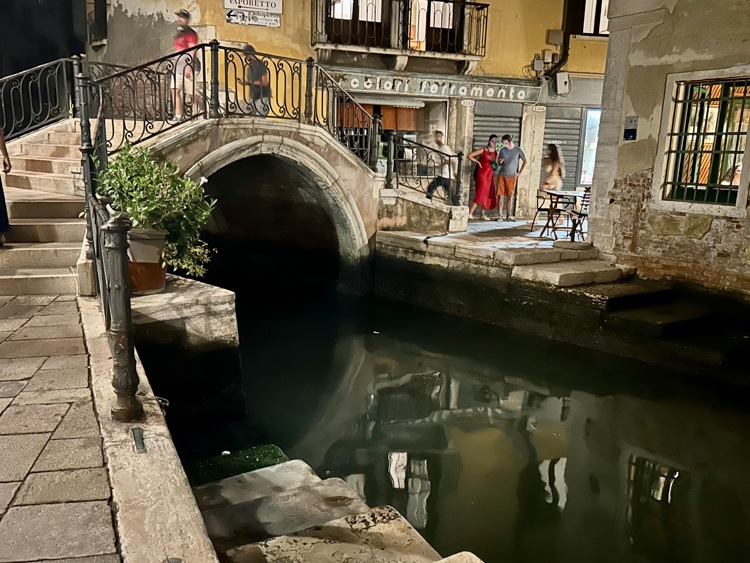
An Italian Pitch
“You speak Italian?” he asked, sitting.
“Piccolo.”
He lit a cigarette and slid his chair a little closer to me before speaking again. “I understand you are considering investing in Venice?”
Initially I was surprised. Then I smiled and tried not to laugh when I figured out the Sicilian server had quite a racket going. I decided to have some fun and play along for a bit.
“You heard that?” I asked, looking around.
The man shrugged his shoulders and took a puff.
I took a sip a sip of my Spritz as he pitched.
“Cannaregio. This is where the real Venetians live. This is the center of Venice,” he said, speaking with conviction. Then he gestured toward the Teatro Italiano: “Grocery.”
“Si. Va bene,” I agreed.
“Many pharmacies. The train station is nearby. How much do you want to spend?”
This time I shrugged.
“The rent for this cafe is 10,000 Euro per-month,” he said, sotto voce-style.
I looked back at the countertop, service bar and small interior with a couple of tables and nodded.
“But I can sell you anything,” the man continued. “An apartment. A store. A house.”
“What have you got?”
“All depends how much you want to spend,” he countered, after a drag on his cigarette. “100-meter apartment?”
“How much?”
“Depends.”
When I finished my spritz, I gave him the slip.
The next night I tried to sneak by unnoticed. But, after three nights of hard-sell, I suspect the Sicilian server would have not have been so attentive.
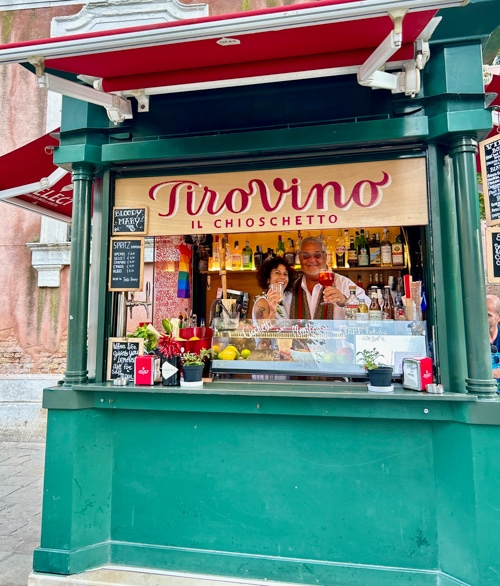
Wandering and Conversing – Campo Sant’ Apostoli
The solitude of Corte Loredana, I never saw another guest there, set my tone for casually bouncing around Venice and lingering throughout the day. Some of the spots I saw were more touristy than others. But, I had plenty of time to turn down streets, peek around corners and engage with locals and travelers. I also had time to soak-in places I previously learned to love and return to them daily.
The Tiro Vino il Chioschetto, a dark green kiosk at Campo Sant’ Apostoli, is one of them. Everyone in the colorful little booth slinging Aperol, Select or Campari spitzes was always been friendly and fun. The spritzes are only four euros. There are no seats outside the kiosk on the edge of the shady square, but people still congregate for laughs and conversation. The kiosk is decorated with funny, cheery messages.
When I asked for a photo, one of the loveley attendants insisted I come inside the kiosk for it and help make a drink.
Campo Sant’ Apostoli, as small and unassuming as it is, is my favorite in Venice. You would pass through it on your walk from Corte Loredana to the Rialto or San Marco areas, as most people do on their way to and from the train station. This makes for fine people-watching, which is one of the reasons I choose to stay put there.
Campo Sant’ Apostoli has shade trees, benches and unassuming café-style restaurants (of varying quality and price) with outdoor dining and gelato shops. There is also a church with a very dramatic interior and an ornate clock tower. Plus, one of Venice’s tiny canals runs right alongside and under a bridge offering gondola rides.
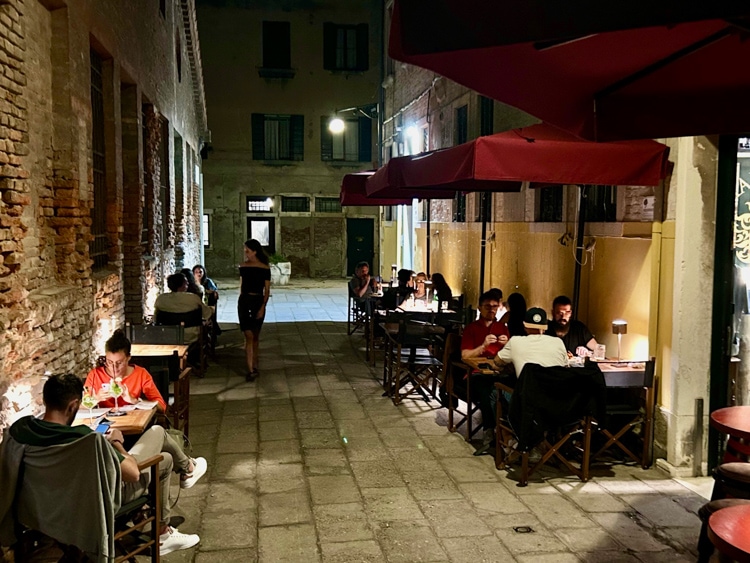
Reveling in Rialto – a Bridge Not too Far
Just a few turns beyond Campo Sant’ Apostoli, between many shops, wine bars and candy stories, you will find the historic Rialto Bridge. The retail area around which has amazing energy. One evening I sat on a chair in front of a bar beside the bridge with my feet on the edge of the Grand Canal watching all manner of boat traffic. Vaporetto, police boats, elegant water taxis, gondolas and garbage barges all churned up the water by gliding in each direction through the narrow canal.
As the sun went down the white, stone bridge lit up. I got a little lit speaking with sets of American tourists who sat next to me at different times. I did not go to Venice to chat with couples from Idaho and Nebraska, but why not? The first husband was a grain tower operator.
To pass the time, and out of admittedly morbid curiosity, I asked him what happens when someone falls into a grain-filled tower. I figured I might never otherwise get the opportunity to find out. He gave me the grim answer…in grainy detail. The second couple told me about their sailing trips.
“A Nebraskan who sails?” I asked.
“I was once in the Navy,” the husband explained.
They would rent a boat in the Virgin Isles and sail through hurricane season each year, when it was less expensive, and catch up at debaucherous Halloween parties. They bought me a drink inside when it started to rain.
Sometimes, if people asked, I revealed that I was a travel writer – and sometimes not. Just like with the mysterious man selling “everything” at Gioig, I just let things play out.
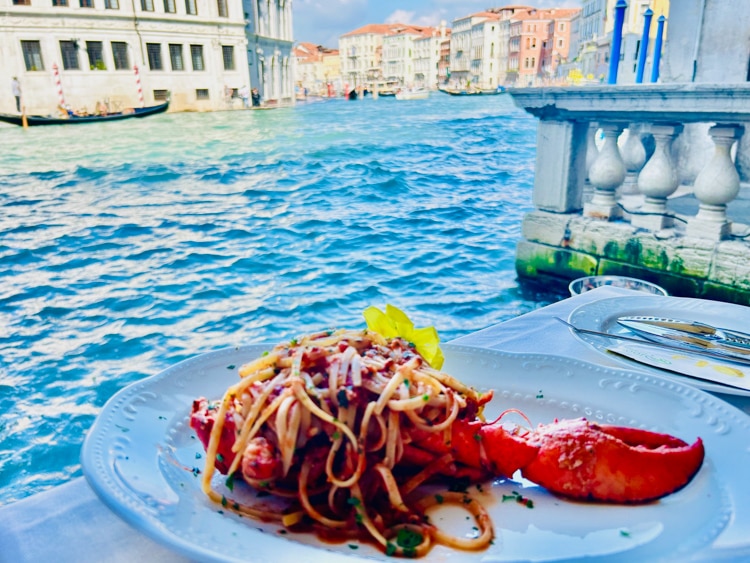
Canalside Cafe
On the other side of the bridge, I found a tiny restaurant called Al Buso Antico Caffe Ristorante. During the day, it was a perfect spot to sit outside under the cool shade of Rialto Bridge. Once again it was on the edge of the Grand Canal so I could watch the boats splash by.
I also had a pretty damned nice pasta-stuffed lobster dish.
Locals will tell you Al Buso is a “tourist restaurant,” but that was part of the fun for me. The way the watery Grand Canal panoramically bends there under the bridge is so scenic that tourists wait in line at a stone railing beside the patio to take preening photos of themselves. I found the poses romantic, sweet and sometimes funny.
Speaking of funny, I asked the manager, since the veranda seating is so close to the steps down into the Grand Canal, if anyone ever falls in.
“Oh, yes. We must remind people all the time to be careful. After enjoying wine and a meal, they get up from their table on the wrong side and tumble in. Sometimes it happens when they are taking photographs,” he revealed. “Last winter a woman fell into the canal. It was freezing and she was wearing a big, wool winter coat. We could not pull her out so we had to call the carabinieri. The police had to come by boat to fish her out rush her to her hotel.”
I admit I looked down at the steep, slippery steps and wondered if I would be able to climb out – even on this very warm day. The old adage about falling into a Venetian canal is not to worry about drowning…but be certain to keep your mouth closed.
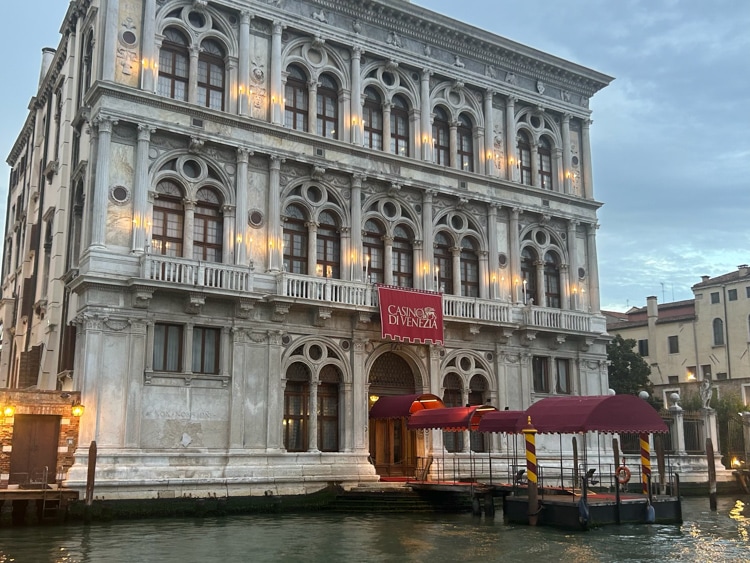
Casino Royale Near Corte Loredana
While most of my time in Venice, as I planned, was spent wandering and hearing stories like that one, Corte Loredana’s proximity to Casino di Venezia – since 1638 the world’s oldest – was too intriguing to not dress up and experience.
The glamorous Grand Canal gaming house is hidden from the main street. But, it is beside the San Marcuola vaporetto dock behind the church, which is close to the Corte Loredana. If you use the waterbus you cannot miss seeing it.
(The casino predates its neighboring San Marcuolo church by 141 years, by the way.) It has a dock for water taxis on the Grand Canal. However, those who enter from the other side, to gamble or enjoy the ornate palazzo’s gourmet restaurant on the second floor, are also treated to a red-carpet entrance.
An elevator up to top-floor gaming area reveals this is no Atlantic City casino. The small, quiet, terrazzo-floored gaming areas are lit by chandeliers and surrounded by authentic sculptures and art work.
Do not be intimidated by the ornate, palatial setting. I found the betting minimums to be happily low and played a little blackjack in the corner. There are some slot machines if you just want to plunk a coin in to say you did it. Appropriate dress is required, however – but not formalwear.
The casino is only open Friday through Sunday nights and there is a 50 euro entry fee. However, 20 of it is refunded in credits to wager. If you are staying in one of Venice’s high-end hotels, the concierge there can arrange for complimentary entry. But I, after all, “living” nearby at Corte Loredana, was a “neighbor.”

Meeting Venetian Friends for a Local Evening
Corte Loredana’s owners, Alberto Venerandi and his wife Giulia de Carolis, invited me to meet them for dinner on a Tuesday evening.
I initially met Giulia when she guided me, on an elegant water taxi at the behest of I.C. Bellagio, from Marco Polo airport to the Hotel l’Orologio during my first visit to Venice on Boxing Day, 2016. We are now friends and are certain to socialize when I am lucky enough to set foot in Venice.
Giulia calls her husband “Albie.” Even while managing a busy renovation project at their own home, Giulia and Albie had me meet them in the evening at the Ponte Scalzi, a bridge crossing the Grand Canal near the train station. When they arrived, Giulia and Alberto extracted me from a restaurant with a flower-filled veranda overlooking the Grand Canal and the bridge.
It was another one of those touristy places where I was paying way too much for the Spritzes I was drinking. The staff was miffed when I took up a table without ordering food. Beware of that in Venice: sitting and drinking just wine or coffee, especially in scenic spots, can be forbidden. I understand the proprietors point.
Aperitivo Time
Giulia and Albie were intent on walking me though a neighborhood and to an authentic wine bar for a pre-dinner “aperitivo”. We found a tiny place full of locals in a little, open-air garden courtyard under the stars.
“Cin cin,” we toasted, honoring the ritual with potions, including a spritz made with asparagus, meant to open our stomachs before dining. We insured this by also tasting some croquetas.
It was very nice to learn about Alberto and his history and about his decision to evolve from operating full-service hotels to a popular, simple property like Corte Loredana. The couple was preparing for a long-awaited trip to Japan within a couple months, so we talked about that. Giulia, in fact, carried around a guide book for their adventure. Their goal was to avoid touristy areas in favor of an authentic, local cultural experience, as we were doing in Venice.
Giulia and Alberto led me, the third-wheel, into a charming local experience as we walked into the night away from the wine bar. As we traversed the small square of Campo San Giacomo da l‘Orio, illuminated only slightly by lampposts, pairs of local couples were waltzing on the pavement to music. The music was played through a speaker by a DJ under a yellow umbrella beside the piazza’s lone tree. It was a charming local gathering between the steeples and stores.
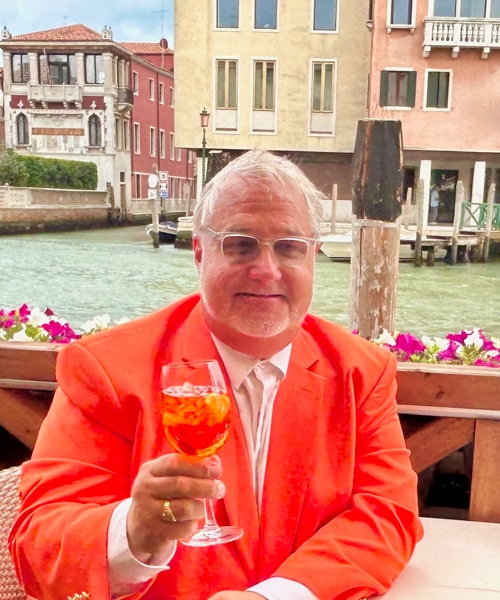
A Pumpkin Night Out at Trattoria La Zucca
Giulia forgot her little sweater—because it was a warm September night so steamy she didn’t need it—at the wine bar. She and I watched the waltzing when Alberto, sweet gentleman that he is, didn’t hesitate to go back and retrieve it.
She told me we were heading to a “cozy, little restaurant called ‘Trattoria La Zucca.’”
“’Zucca’ means ‘pumpkin’ but not every dish is made with pumpkin,” Giulia, a vegetarian, assured me.
She allowed that it can be challenging to secure a reservation at Zucca because it is very popular. But I remembered that, as an IC Bellagio logistical expert, Giulia can manage every nuance of the real, local, inside Venice. Apparently, so too can her husband, Alberto.
With his lifetime of local knowledge, he took a short cut back through the maze of Venice’s passageways and managed to already be standing on the little canal bridge beside Trattoria La Zucca when we arrived. It was like a magic trick.
There are only 35 seats at the oak and copper-accented Zucca. We were seated inside by the front window and laughed our heads off when Zucca’s manager made fun of the bright orange blazer I was wearing.
“Maybe a little too much ‘pumpkin!’” he joked about the jacket’s color.
“That is funny since Venice’s famous Aperol Spritz is the ‘orangest’ colored drink of all!” I countered.
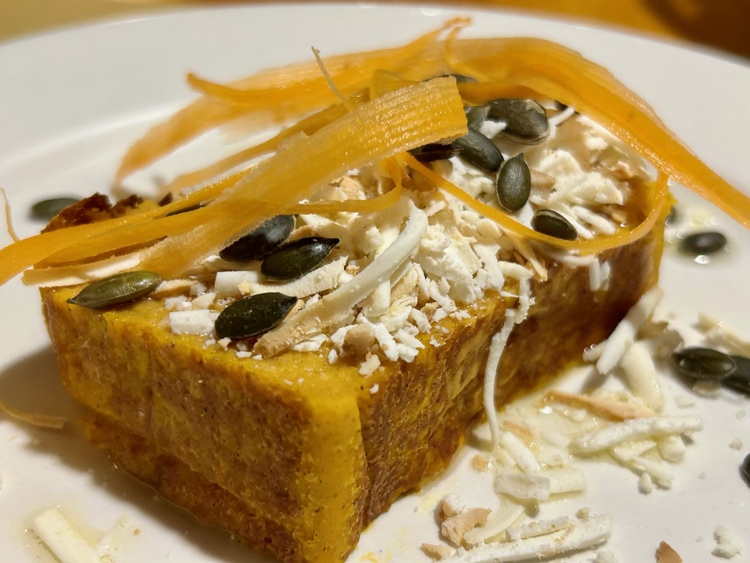
A Delicious Meal Paired With Local Wine
We drank locally produced white wine, which was brought out with snacks. This included Tarallo, which I learned were very hard, little, olive oil-flavored pretzel-like, donut-shaped biscuits.
Somewhere between the crunching a joke was made about the Tarallo being as hard as someone’s head, but I cannot remember whether Giulia or Alberto was the stubborn one being teased.
Each day, Zucca has a new menu of Venetian traditional and fusion dishes. Giulia was kind enough to translate it. I encouraged her to choose the items as well, which we all admired and shared:
The antipasti dishes cost about 15 euros, such as straccetti di polo con verdure allo zenzero e riso.
Primi the likes of Sfornatino di carciofi con fonduta di parmigano and Vellutata de Zucca e carote. We also tried Flan de Zucca con burro and salvia e ricotta affumicata. Plus, I noticed baked lasagna and pastas on the menu.
One of our secondi, at about 25 euros, was Coniglio in umido con olive taggiasche e friggitelli. Giulia also recommended one of the sides, Gratin de patate e zucca con parmigiano.
No one ever wants to admit they have room for dessert. But our dolce delights were Sorbetto de Pesche al Prosecco and Panna Cotta con salsa di uva fregola.
The dear, generous couple insisted on walking me, even though it was out of their way, back to Ponte Scalzi, the bridge from which they knew I could find my way back to Corte Loredana.
Getting Lost Again
I was still intent on getting lost in Venezia’s labyrinth of narrow passageways—the Calle Varisco, for instance, is only 53 cm wide. The walkways are teeming with tourists and crossed by canals. Emerging into Piazza San Marco, one can spread out a little bit between Caffe Florian and Caffe Quadri. Here, the orchestras play to tented seats on each side of the square.
Even in the square, one must slip beside the selfie-shooters and souvenir sellers slinging little lights into the sky. Plus, the pilgrims queueing up to enter the basilica.
It can be very humid in Venice, which stands on a sea-level series of little islands in a steamy lagoon. During a day spent walking and exploring, I try to find places to “chill,” for lack of a better word. Two of my “old standbys” are the stone steps of the soaring Santa Maria della Salute cathedral which is shaded at the right time of day.
The steps serve as bleachers overlooking the Grand Canal and, across, Palazzo Ducale and the campanile looming over San Marco. So, people sit, and when they are not checking their phones, gaze at the placid panorama of gondolas and gargoyles. There is also a convenient vaporetto water bus dock steps from the steps.
If you are getting your steps in, I suggest you circle around behind the cathedral. Or, cut through the island to its’ breezy back along the Fondameniaza Tere Allo Spirito Santo, unobstructed beside the wide canal with a view of the island of Giudecca and its stunning, towering churches. (Giulia, of course, initially showed me this spot on a previous visit during the chilly air of late November.)
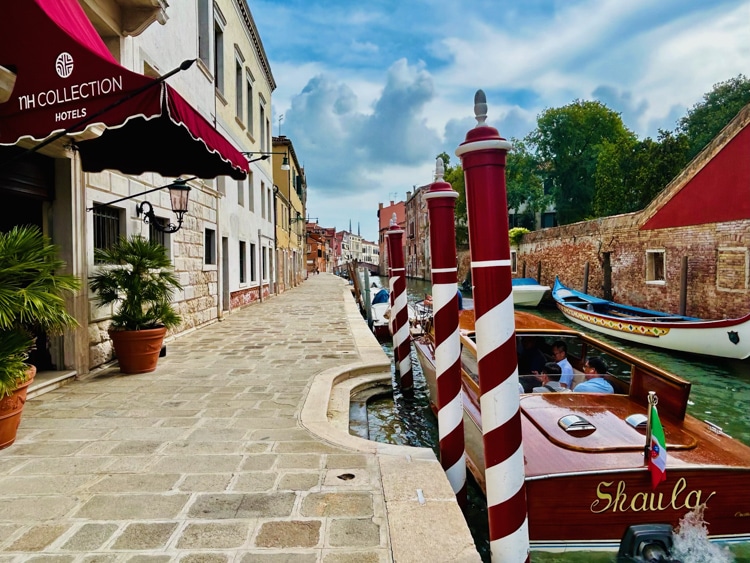
Photo by Harrison Shiels
Another Nearby Treasure Tip
Wandering Corte Loredana’s Cannaregio neighborhood will yield a surprise. Two narrow passageways and two small bridges away, but less than five minutes’ walk, you will find the secret walled gardens and grounds of the NH Collection Grand Hotel Palazzo Dei Dogi. It is a 64-room 17th-century palazzo.
Its understated front entrance is on a narrow canal 300 meters from the Madonna dell’Orto vaporetto dock, named for the adjacent church, the gothic burial place of the important Venetian painter Tintoretto.
That dock and others nearby, including the hotel’s private pier, are on the Venetian Lagoon across from the famed glass-making island of Murano at the back of the hotel property, and some of its rooms look over.
La dolce vita!
Read more of Michael Patrick’s work at The Travel Tattler and contact him at [email protected]
Inspire your next adventure with our articles below:
- Chef Massimo Bottura’s Travel Trail – From Modena to Monaco and More - June 30, 2025
- Hilton’s Miami Airport Blue Lagoon Hotel – A Vibrant, Cultural Gateway to Havana - April 30, 2025
- Spend a Life at Sea Amidst Crystal Cruises Cuisine and Cache - April 19, 2025
